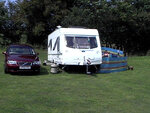Just occasionally we'll pick a pitch that has quite a slope on it to the extent that we can't raise or lower the jockey wheel enough without unclamping it.
Usually after my morning bowl of porridge I can hold the hitch up while my wife unclamps the jockey wheel and raises or lowers it before I pass out. After which we can do the usual adjusting
I've got a couple of ideas to make life easier but does anyone have any tips other than steroids 😉
Usually after my morning bowl of porridge I can hold the hitch up while my wife unclamps the jockey wheel and raises or lowers it before I pass out. After which we can do the usual adjusting
I've got a couple of ideas to make life easier but does anyone have any tips other than steroids 😉



